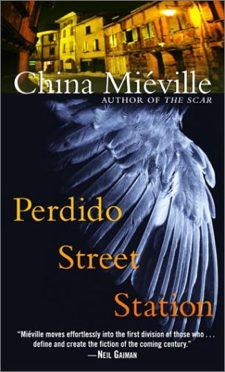The right side of my brain wants to delve deeply into the enchantment of China Miéville’s Perdido Street Station, and the left side of my brain, annoyingly, wants to explain how it’s done. In this brief appreciation, I’ll give the right side full rein, and engage the left side periodically.
First of all, Perdido Street Station is brimming with enchantment. Written in intense, evocative prose, set in Dickensian New Crobuzon, peopled with characters of Boschian demeanor and diversity—four different kinds of humans and some three dozen other sentient and insentient species and entities—the book flourishes and shuffles the conventions of science fiction, fantasy, and horror: twirls them, riffles them, fans them, springs them, and carousels them before the gaze of the delighted reader.
A lot of the right-brain fun at the beginning of the book results from the baroque breadth of Miéville’s imagination and language, and from his detailed, well-realized images of a complex city, filled with people of all classes, races, and resources. Some of this is predicated upon Niven’s Converse of Clarke’s Third Law: magic is the steam engine of New Crobuzon. Thaumaturgic technology drives the wheels of industry, feeds and punishes the people, and is responsible for the logical strangeness of New Crobuzon, both sides of the reader’s brain chugging away at the same time.
Miéville created the teeming city with an understanding of the complex economic and political structures that underlie our own 19th century industrial revolution, drawing on his academic background in social anthropology and international trade. He hints at histories and geographies outside the city as well: it is clear that the world, Bas-Lag, is larger than this one book, and that he crafted its underpinnings carefully. This yields a wonderful tension, in the book, between magic and reality. Economics, of course, is not easily classified as either.
The reader learns about the city, its inhabitants, and the events of the story from two different points of view: one that of a newcomer with a mysterious and traumatic past, and the other a sort of combo of multiple third-person-limited and omniscient viewpoints that dip into various characters minds as needed, including that of a local Bohemian, his unconventional insectoid girlfriend, and a grub metamorphosing into a giant slakemoth. This is less confusing than it ought to be by general aesthetic rules: it works.
The railway station of the title does not feature in much of the book, though it is the crossroads of New Crobuzon and a metaphoric stand-in for the city itself. The plot, less complex than the setting, is driven by what initially seems to be a McGuffin, but which, after hundreds of pages, suddenly erupts, taking over the book and the city and the station, and ending in tragedy and loss and redemption.
But this is not a book you read for plot, even the first time through. The first time, you read it as a travelogue of New Crobuzon: you read it for the right-brain enchantment of its mysteries, and for the left-brain joy of unfolding them and figuring out what’s going on. After that, you re-read it for the pleasurable intricacy of Bas-Lag’s cultural and economic substructures and to appreciate the inventive strangeness of the social details – languages, clothing, cultural artifacts and the like – that you zipped past the first time. For a third reading, you’ll especially value the maps, both in the book and on the web, and the remarkable density of deep background available on the web for Perdido Street Station and its related books, The Scar and The Iron Council.
Eileen Gunn is the author of a small but distinguished body of short fiction published over the last three decades. Her story “Coming to Terms” won the Nebula Award in 2004. The same year saw the publication of her collection Stable Strategies and Others.
Her other work in science fiction includes editing the pioneering webzine The Infinite Matrix and producing the website The Difference Dictionary, a concordance to The Difference Engine by William Gibson and Bruce Sterling. A graduate of Clarion, Gunn now serves as a director of Clarion West.










